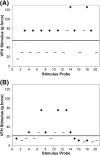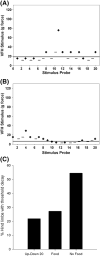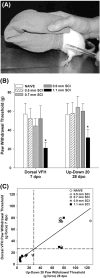Validity of acute and chronic tactile sensory testing after spinal cord injury in rats
- PMID: 20643128
- PMCID: PMC4933012
- DOI: 10.1016/j.expneurol.2010.07.009
Validity of acute and chronic tactile sensory testing after spinal cord injury in rats
Abstract
Spinal cord injury (SCI) impairs sensory systems causing allodynia. Measuring the development of allodynia in rodent models of SCI is challenging due to spinal shock and marked motor impairments. Assessment of SCI-induced allodynia is not standardized across labs, making interpretation of results difficult. Therefore, we validated sensory threshold assessment after SCI and developed a novel assessment of allodynia prior to motor recovery in a rat SCI model. One hundred fifty-six Sprague-Dawley rats received T8 laminectomy or mild to moderate SCI using the OSU SCI device (0.3 mm to 1.3 mm cord displacement). To determine tactile thresholds, von Frey hairs (VFH) were applied in Up-Down or ascending order to the dorsal or plantar hindpaw. The most efficient and valid procedures that maintain high sensitivity and specificity were identified. Ten Up-Down VFH applications yielded stable thresholds; reducing the risk of threshold decay and unnecessary exposure to painful stimuli. Importantly, distraction of SCI-rats with food revealed differential decay of thresholds than when distraction is not provided. The new test uses dorsal VFH stimulation and is independent of trunk or hindlimb control. Acute dorsal VFH thresholds collected before recovery of hindlimb weight support accurately predicted plantar VFH thresholds measured at late timepoints (chi(2)=8.479; p<0.05). Thus, standardized testing early after SCI using the dorsal VFH test or later using 10 stimuli in the Up-Down test produces valid measures of tactile sensation across many SCI severities. Early detection of allodynia in experimental SCI will allow identification of mechanisms responsible for pain development and determine targets for therapeutic interventions.
Published by Elsevier Inc.
Figures






Similar articles
-
Acute and chronic tactile sensory testing after spinal cord injury in rats.J Vis Exp. 2012 Apr 4;(62):e3247. doi: 10.3791/3247. J Vis Exp. 2012. PMID: 22508401 Free PMC article.
-
An analysis of changes in sensory thresholds to mild tactile and cold stimuli after experimental spinal cord injury in the rat.Neurorehabil Neural Repair. 2000;14(4):287-300. doi: 10.1177/154596830001400405. Neurorehabil Neural Repair. 2000. PMID: 11402879
-
Chronic at- and below-level pain after moderate unilateral cervical spinal cord contusion in rats.J Neurotrauma. 2013 May 15;30(10):884-90. doi: 10.1089/neu.2012.2632. J Neurotrauma. 2013. PMID: 23216008 Free PMC article.
-
Effects of early surgical decompression on functional and histological outcomes after severe experimental thoracic spinal cord injury.J Neurosurg Spine. 2017 Jan;26(1):62-75. doi: 10.3171/2016.6.SPINE16343. Epub 2016 Sep 16. J Neurosurg Spine. 2017. PMID: 27636866
-
Calcium channel alpha-2-delta-1 protein upregulation in dorsal spinal cord mediates spinal cord injury-induced neuropathic pain states.Pain. 2011 Mar;152(3):649-655. doi: 10.1016/j.pain.2010.12.014. Epub 2011 Jan 15. Pain. 2011. PMID: 21239111 Free PMC article.
Cited by
-
Experimental spinal cord injury and behavioral tests in laboratory rats.Heliyon. 2019 Mar 8;5(3):e01324. doi: 10.1016/j.heliyon.2019.e01324. eCollection 2019 Mar. Heliyon. 2019. PMID: 30906898 Free PMC article. Review.
-
Sovateltide (ILR-1620) Improves Motor Function and Reduces Hyperalgesia in a Rat Model of Spinal Cord Injury.Neurocrit Care. 2024 Oct;41(2):455-468. doi: 10.1007/s12028-024-01950-2. Epub 2024 Mar 5. Neurocrit Care. 2024. PMID: 38443708
-
Sexual Dimorphism in Lesion Size and Sensorimotor Responses Following Spinal Cord Injury.Front Neurol. 2022 Jul 19;13:925797. doi: 10.3389/fneur.2022.925797. eCollection 2022. Front Neurol. 2022. PMID: 36994113 Free PMC article.
-
Rolipram-loaded PgP nanoparticle reduces secondary injury and enhances motor function recovery in a rat moderate contusion SCI model.Nanomedicine. 2023 Sep;53:102702. doi: 10.1016/j.nano.2023.102702. Epub 2023 Aug 11. Nanomedicine. 2023. PMID: 37574117 Free PMC article.
-
Red-Light (670 nm) Therapy Reduces Mechanical Sensitivity and Neuronal Cell Death, and Alters Glial Responses after Spinal Cord Injury in Rats.J Neurotrauma. 2020 Nov 1;37(21):2244-2260. doi: 10.1089/neu.2020.7066. Epub 2020 Aug 10. J Neurotrauma. 2020. PMID: 32552352 Free PMC article.
References
-
- Aminabadi NA, Farahani RM, Balayi Gajan E. The efficacy of distraction and counterstimulation in the reduction of pain reaction to intraoral injection by pediatric patients. J Contemp Dent Pract. 2008;9:33–40. - PubMed
-
- Basso DM. Behavioral testing after spinal cord injury: congruities, complexities, and controversies. J Neurotrauma. 2004;21:395–404. - PubMed
-
- Basso DM, Beattie MS, Bresnahan JC. A sensitive and reliable locomotor rating scale for open field testing in rats. J Neurotrauma. 1995;12:1–21. - PubMed
-
- Basso DM, Beattie MS, Bresnahan JC, Anderson DK, Faden AI, Gruner JA, et al. MASCIS evaluation of open field locomotor scores: effects of experience and teamwork on reliability. Multicenter Animal Spinal Cord Injury Study. J Neurotrauma. 1996;13:343–359. - PubMed
Publication types
MeSH terms
Grants and funding
LinkOut - more resources
Full Text Sources
Other Literature Sources
Medical

